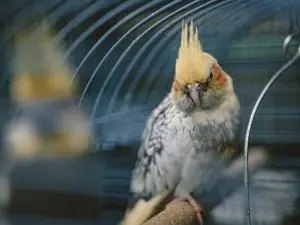
Cockatiels are cute little birds with beaks that are usually beige or grey-black, so, if your bird’s beak starts to look different than normal you’d be right to be concerned.
This article is a look into why your cockatiel has developed a brown spot on its beak.
Table of Contents
Brown spot on cockatiel beak:
A change in your bird’s appearance can tell you a lot about a bird, changes generally mean that something is going on with your bird.
Here are reasons why your cockatiel may have developed a brown spot on its beak:
Wear and tear:
Cockatiel beaks are made out of keratin, the keratin on your bird’s beak is always growing. This keratin will be worn down by the bird through everyday activities.
However, if your bird rubs its beak too much, on its cage bars or on its perch, then it can develop a brown wear mark and this may be what you’re seeing.
What to do:
This is not normal behavior and you may want to take your bird to the vet for an assessment and an examination.
A bruise:
The outer layer of your bird’s beak is made up of keratin, the same material that our fingernails are made up of, the inner layer of the bird’s beak is a bony layer and there are capillaries that transport blood throughout the bird’s beak between these two layers.
If your bird injures its beak then these blood vessels will become damaged and blood will pool in the beak, you will see this as a brown or black spot on your cockatiel’s beak.
What to do:
What you do in this case will be determined by how the bird is acting while bruised. If the bird is eating as normal, still flies normally, still plays normally, and doesn’t seem to be in any sort of pain then you can let the bird be.
The bruise will heal on its own and won’t cause issues with your bird.
The bruise will not heal like a human bruise will but it will heal nonetheless. It will grow along with the beaks keratin and will be worn away as the bird wears its beak away
Liver disease:
Liver disease, namely fatty liver disease, is another cause of brown spots on your bird’s beak. Fatty liver disease, as the name suggests results in the collection of fat on the bird’s liver.
This is most common in birds who eat a high-seed diet and not a pellet diet, seeds are rich in fat. This ailment causes blood clots in your bird.
Some of these blood clots can show up in your bird’s beak and will look like a brown spot
Other signs of fatty liver in your birds include black spots developing on the bird’s feet, abnormal beak growth, abnormal toenail growth, yellow stained urates, increased regurgitation, black toenails, wet droppings, issues with breathing, and more.
What to do:
This is a serious condition, it can be treated if caught early on but if not treated then it can be very dangerous for your bird.
It is recommended that you take the bird to the vet for diagnosis and treatment, take your bird to an avian vet if you can.
If you enjoyed this article then you may also be interested in other bird related articles. Here are some articles that you may be interested in: Parrot Feathers Turning White?, Sun Conure Feathers Turning White, Why Do My Budgie’s Feathers Look Scruffy?, Why Does My Parrot Look Scruffy?, Brown Spot On Parakeets Beak

